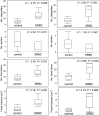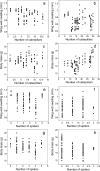Immune challenge of female great tits at nests affects provisioning and body conditions of their offspring
- PMID: 28955122
- PMCID: PMC5591367
- DOI: 10.1007/s10211-017-0265-4
Immune challenge of female great tits at nests affects provisioning and body conditions of their offspring
Abstract
The trade-off between animal's parental reproductive effort and survival is still poorly understood. Parental allocation between the workload during breeding attempts and the parents' own body conditions can be assessed through the offspring quality. Here, I questioned whether the immune responsiveness of female great tits may be considered as a mediator of this trade-off. Specifically, I tested whether (1) the parental reproductive effort decreases, (2) the food composition provided to chicks changes, and (3) whether the nestling immunocompetence and body mass decrease after experimental immunisation. Two populations of great tit Parus major occupying nest boxes were studied in Niepołomice Forest and Krzyszkowice Forest (Southern Poland) in 2011 and 2012, respectively. Three days after hatching, half of the females were challenged with sheep red blood cells (SRBC), while other females were injected with phosphate-buffered saline PBS (control). Six days later, food provided by the parents was collected from nestlings. After another 2 days, the offspring's body mass was measured and wing web swelling in response to an additional phytohaemagglutinin (PHA) injection. In both years, immunocompetence and in 2012 also body mass in the offspring of SRBC-immunised mothers were lower than in control nestlings, indicating a cost of mounting the immune response in the female. Six days after the start of the female treatment, the number of caterpillars and the volume of food items provided by parents to chicks were higher, whereas the number of spiders was lower in nests with SRBC treatment than in control ones. This might be explained by compensational parental feeding after recovery from the inflammation of a female. Thus, the trade-off between parental effort and survival of parents is mediated by the costs incurred for their immunity and can be assessed by the amount and quality of food provided to the nestlings and the offspring condition.
Keywords: Breeding attempt; Caterpillars; Nestlings; Parental investment; Phytohaemagglutinin (PHA) injection; Sheep red blood cells; Spiders.
Figures




Similar articles
-
Experimental removal of the male parent negatively affects growth and immunocompetence in nestling great tits.Oecologia. 2005 Aug;145(1):165-73. doi: 10.1007/s00442-005-0088-2. Epub 2005 Jul 31. Oecologia. 2005. PMID: 15891821
-
Immune function and survival of great tit nestlings in relation to growth conditions.Oecologia. 1999 Nov;121(3):316-322. doi: 10.1007/s004420050934. Oecologia. 1999. PMID: 28308319
-
Great tits feed their nestlings with more but smaller prey items and fewer caterpillars in cities than in forests.Sci Rep. 2021 Dec 17;11(1):24161. doi: 10.1038/s41598-021-03504-4. Sci Rep. 2021. PMID: 34921179 Free PMC article.
-
Parental food provisioning is related to nestling stress response in wild great tit nestlings: implications for the development of personality.Front Zool. 2015 Aug 24;12(Suppl 1):S10. doi: 10.1186/1742-9994-12-S1-S10. eCollection 2015. Front Zool. 2015. PMID: 26913051 Free PMC article. Review.
-
Food availability limits avian reproduction in the city: An experimental study on great tits Parus major.J Anim Ecol. 2020 Jul;89(7):1570-1580. doi: 10.1111/1365-2656.13211. Epub 2020 May 17. J Anim Ecol. 2020. PMID: 32419138
Cited by
-
Fifty years of sheep red blood cells to monitor humoral immunity in poultry: a scientometric evaluation.Poult Sci. 2020 Oct;99(10):4758-4768. doi: 10.1016/j.psj.2020.06.058. Epub 2020 Jul 15. Poult Sci. 2020. PMID: 32988510 Free PMC article.
-
Artificial light at night weakens body condition but does not negatively affect physiological markers of health in great tits.J Exp Biol. 2025 Jul 1;228(13):jeb249926. doi: 10.1242/jeb.249926. Epub 2025 Jul 7. J Exp Biol. 2025. PMID: 40509875 Free PMC article.
References
-
- Alonso-Alvarez C, Tella JL. Effects of experimental food restriction and body-mass changes on the avian T-cell mediated immune response. Can J Zool. 2001;79:101–105. doi: 10.1139/z00-190. - DOI
-
- Barbosa A, Moreno E. Cell-mediated immune response affects food intake but not body mass: an experiment with wintering great tits. Ecoscience. 2004;11:305–309. doi: 10.1080/11956860.2004.11682837. - DOI
-
- Brinkhof MWG, Heeb P, Kolliker M, Richner H. Immunocompetence of nestlings great tits in relation to rearing environment and parentage. Proc R Soc Lond B Biol Sci. 1999;266:2315–2322. doi: 10.1098/rspb.1999.0925. - DOI
LinkOut - more resources
Full Text Sources
Other Literature Sources
